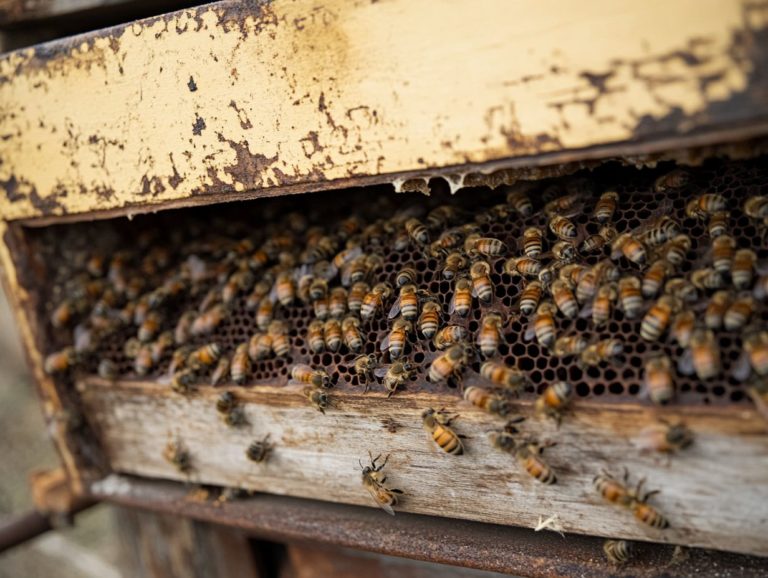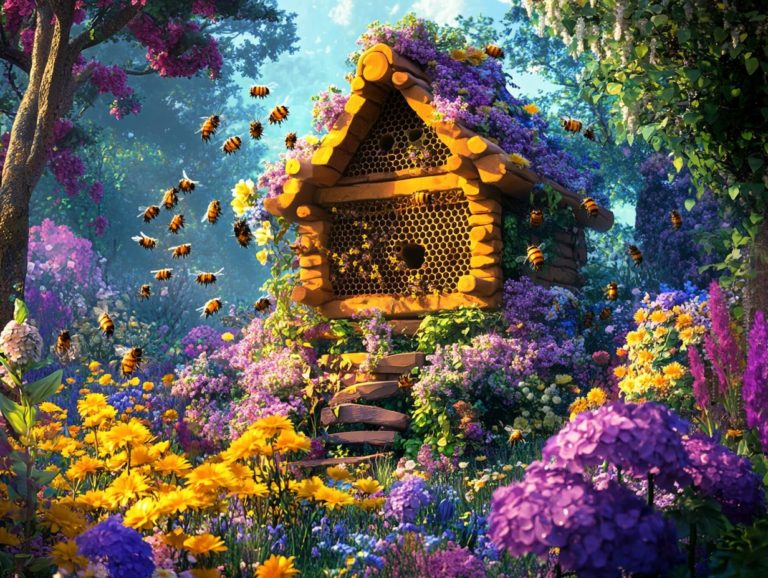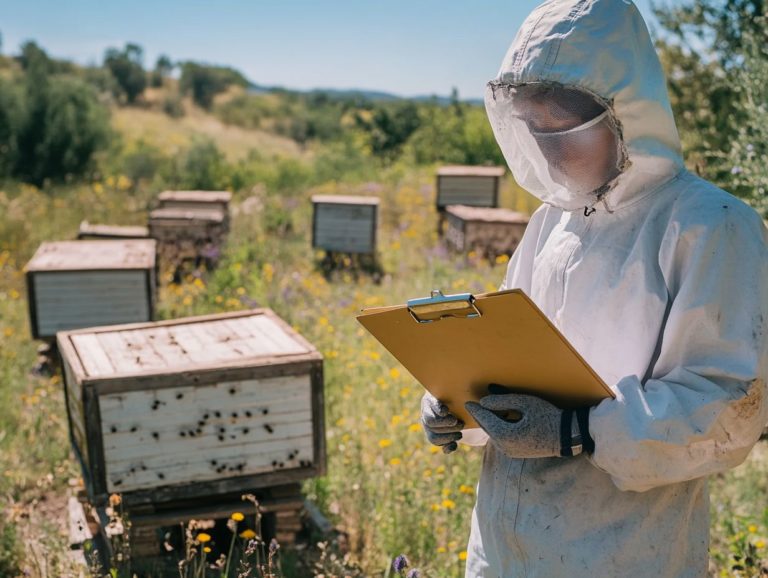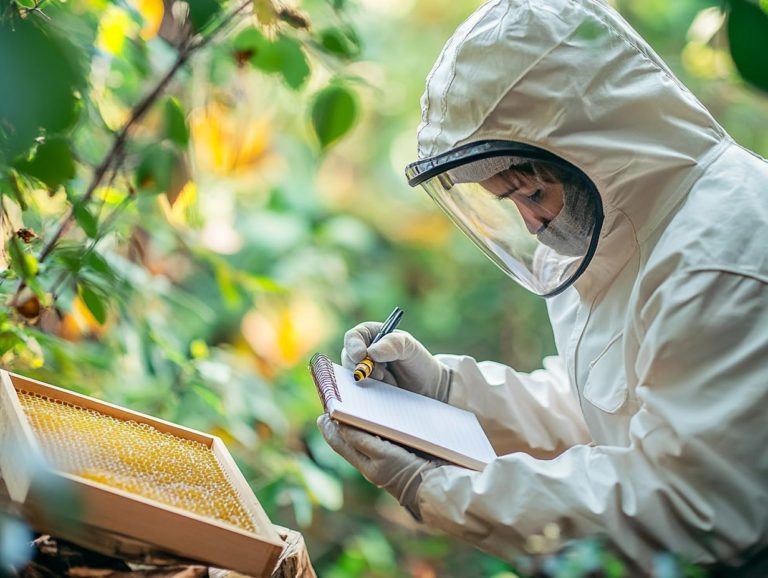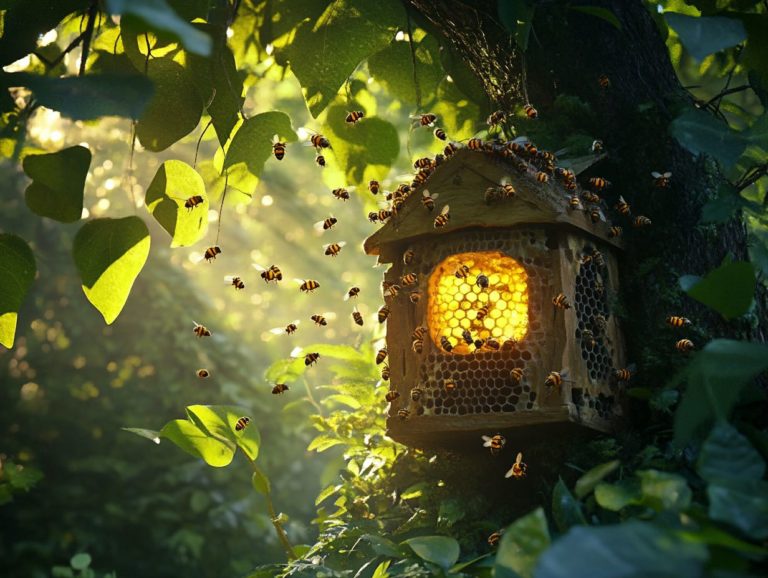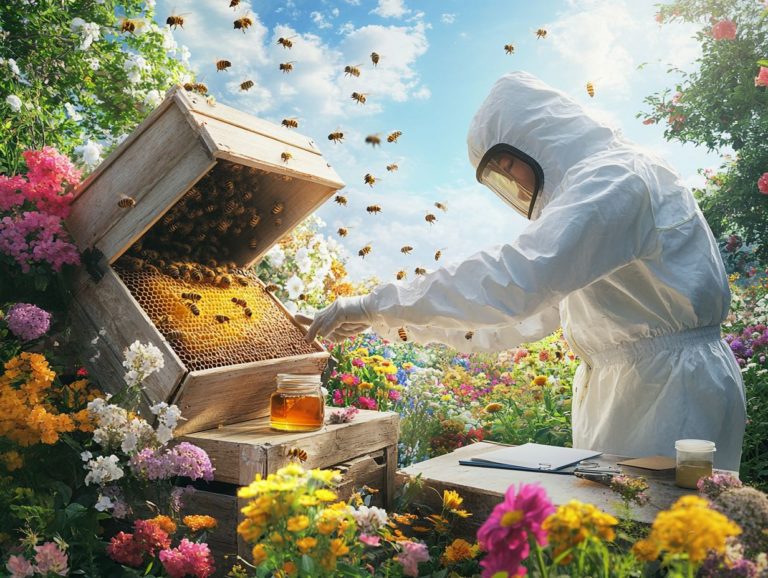Best Practices for Hive Feeding
Hive feeding stands as a vital component of successful beekeeping, ensuring that your colonies flourish, particularly during tough seasons when natural food sources are insufficient.
Grasping the nuances of how to effectively feed your bees, including understanding various feeding techniques and equipment, can profoundly impact their health and productivity.
This article delves into the essence of hive feeding, its significance, an array of feeding methods, and best practices to elevate your approach, ensuring you address the nutritional needs of your bees with both natural and artificial feed sources.
Whether you re an experienced beekeeper or just embarking on your journey, you ll uncover valuable insights to guide you in selecting the ideal feeder, from top feeders to in-hive feeders, and nurturing thriving, healthy hives.
Contents
Key Takeaways:
- Provide a variety of food sources to ensure proper nutrition for your hive.
- Regularly monitor food stores to prevent starvation or overfeeding.
- Choose the right feeder for your hive based on size, budget, and research.
What is Hive Feeding?
Hive feeding is the art of offering supplementary nourishment to honey bees in a thoughtful and controlled manner. This practice aims to support their nutritional needs and enhance the overall health of the colony.
It becomes especially crucial when natural food sources dwindle, such as during nectar dearth (a time when flowers produce little nectar) or the winter months.
Typically, this involves preparing a sugar syrup a blend of sugar and water that effectively mimics the natural feeding behaviors observed during nectar flow. By doing so, you ensure that your bees have access to adequate carbohydrates and protein, essential for brood rearing (the process of raising young bees) and maintaining the hive’s vitality.
Why is Hive Feeding Important?
Hive feeding is essential for maintaining the health of your colony and ensuring that your honey bees thrive, especially during those times of the year when natural food sources like pollen and nectar become scarce.
Not feeding your bees properly risks a drop in honey production and potentially jeopardizes the survival of your bees.
An inadequate food supply can have severe consequences for the overall health of bee populations. It is vital for you to establish regular feeding schedules.
Factors such as Florida’s intense heat only heighten this urgency. High temperatures can rapidly deplete stored resources, increasing the risk of starvation for your bees.
As a beekeeper, it s important for you to take a proactive stance by developing effective emergency feeding strategies to ensure your hives receive adequate nutrition during critical times.
Using pollen substitutes and other artificial substitutes not only fulfills the nutritional needs of your honey bees but also helps maintain the strength of your hive. This comprehensive approach bolsters the resilience of your colonies, enabling them to withstand environmental challenges and truly thrive.
What are the Different Methods of Hive Feeding?
You have a variety of hive feeding methods at your disposal to ensure your bee colonies receive the nourishment they need. One popular approach is using sugar water mixtures, which can be delivered through an array of feeding equipment.
Options like top feeders, entrance feeders, and in-hive feeders are all designed to meet specific needs and circumstances within your hive. This allows you to tailor your feeding strategy for optimal results and support bee survival.
Implement hive feeding methods today and share your experiences with fellow beekeepers!
1. Top Feeding
Top feeding is a popular method for beekeepers. It places feeding equipment directly on the hive, allowing bees easy access to sugar syrup.
This approach boosts feeding efficiency and creates a better living space for bees. By encouraging bees to draw directly from the feed source, you can significantly reduce the chances of spills and contamination.
Top feeding adapts well to various hive types whether you re working with Langstroth, Top Bar, or Warre hives. This method is especially helpful when temperatures fluctuate, as the warmth generated by the colony prevents the feed from crystallizing or becoming too thick for the bees to consume effortlessly.
Ultimately, using this method supports the overall health of the colony during critical periods. It aids in bee development and enhances honey production and hive activity.
2. Boardman Feeder
A Boardman feeder is a cleverly designed tool that offers easy access for bees. It is typically mounted right at the entrance of the hive, allowing your bees to feed on sugar syrup without the hassle of manipulating the hive structure.
This straightforward design provides numerous advantages for both novice and seasoned beekeepers. The simplicity of the Boardman feeder enables quick installation. It allows your bees to access the sugar solution effortlessly during times of scarcity.
Keep a close eye on the sugar concentration to ensure your bees thrive! Regular maintenance of the feeder such as routine cleaning and refilling can significantly enhance its effectiveness and contribute to the overall health of your hive, ultimately fostering a thriving bee population.
3. Frame Feeder
Frame feeders represent a remarkable advancement in in-hive feeding methods. They fit seamlessly into the brood chamber. This innovative design allows your bees to access sugar syrup while minimizing the risk of robbing, which is when bees from other colonies steal honey.
These feeders offer a practical solution for you as a beekeeper. They help maintain healthy colony weight and overall hive health, especially during challenging times when nectar flow is scarce.
The clever design facilitates efficient feeding while keeping the syrup concealed from potential predators and robbing bees. This minimizes competition and stress within the colony.
However, consider some downsides, such as the difficulty in monitoring syrup consumption and potential cleanliness issues if not managed properly. For optimal sugar concentration, mix sugar with water in a 1:1 ratio during the early season. Transition to a more concentrated 2:1 mixture as fall approaches. This ensures that your bees receive the energy they need to thrive.
4. Division Board Feeder
Division board feeders are sophisticated feeding devices designed to replace a frame in your hive. They offer easy access to liquid feed, making them an ideal choice for beekeepers who want to provide sugar syrup during critical feeding periods.
By integrating seamlessly into the structure of your hive, these feeders enhance the efficiency of your feeding practices. They maintain a healthy balance within the colony by ensuring that your bees have a reliable source of nutrition, particularly during times of scarcity, such as late winter or early spring.
In emergencies, when natural foraging is off the table, division board feeders become essential for the survival of your bees. They grant immediate access to energy-rich sugar syrup, which supercharges bee health and energy!
This capability promotes consistent brood production and hive activity, ultimately paving the way for the long-term prosperity of your colony.
5. Entrance Feeder
Entrance feeders offer you a simple and efficient way to provide sugar syrup to your honey bees by placing the feed directly at the hive entrance. This approach facilitates quick access for foraging bees, making it a thoughtful choice for any beekeeper.
Not only does this method encourage foraging activity, but it also minimizes the risk of disrupting your colony’s natural behavior. With easy access to the syrup, bees can feed without leaving the hive entrance exposed for too long. Installation is a breeze most feeders fit seamlessly at the entrance and can be securely positioned to prevent leaks or pest intrusions.
By strategically utilizing entrance feeders, you can significantly enhance your colony s health, especially during the winter months or times of scarce nectar flow. Ensuring a steady supply of nutrients supports healthy brood development and fosters resilience against diseases.
Interestingly, the placement and type of feeder you choose can influence bee activity patterns and feeding behavior, allowing for a more dynamic and responsive beekeeping experience.
What are the Best Practices for Hive Feeding?
Implementing best practices for hive feeding is crucial for ensuring the survival of your bees and maintaining the overall health of the colony. This involves regularly checking food stores, utilizing appropriate feeding techniques, and following established feeding guidelines that consider surrounding temperature and seasonal fluctuations in nectar flow.
By adhering to these principles, including maintaining optimal sugar concentration in feed solutions and using various feeding methods, you contribute significantly to the vitality and longevity of your beehive.
1. Provide a Variety of Food Sources
Providing a range of food sources, such as sugar syrup, sugar water, pollen substitutes, protein sources, and natural food options, is essential for maintaining a balanced diet for your honey bees. This ensures both their health and the productivity of the colony.
When your colony has access to diverse nutrition, it not only supports brood rearing but also enhances the overall vitality of the hive. Different food sources can significantly improve the bees’ ability to build healthy comb, which is crucial for storing honey and raising new bees. Effective bee feeding can lead to better comb building.
By incorporating various nutrients from both natural and supplemental feeds, including artificial feed, you enable your bees to optimize their foraging efforts and bolster their immune systems. This diverse diet fosters resilience against disease and strengthens the colony’s adaptability to environmental changes, emphasizing that balanced bee feeding is paramount for sustainable beekeeping.
2. Monitor Food Stores Regularly
Regularly checking your food stores is crucial for keeping your bees healthy and happy! This practice allows you to assess the nutritional needs of your colonies. It ensures that your honey bees have the resources they require to survive and thrive, especially during challenging periods of nectar dearth and nectar flow.
This practice goes beyond just checking the amount of stored honey; it also requires you to pay attention to sugar reserves and pollen stores when natural food sources are scarce. Conducting hive inspections will enable you to visually evaluate the vitality of the colony, helping you spot any signs of hunger or stress.
Adjusting your feeding practices based on the weight of the hive can offer critical insights; if your hive feels lighter, it s a clear sign you need to act fast and provide supplemental feeding!
Observing the activity levels of your bees on warmer days can guide you in determining the need for additional food sources. A hive buzzing with busy foragers may suggest that the colony is actively consuming its stored resources, signaling that you might need to step in and provide more nourishment.
By following these best practices, you can ensure your bees thrive and your beekeeping journey is a success!
3. Use Proper Feeding Equipment
Using the right feeding equipment, such as in-hive feeders and top feeders, is crucial for effective hive feeding. This ensures safe and efficient delivery of sugar syrup and nutritional supplements directly to your bees.
As a beekeeper, you have various feeding equipment options at your disposal, each tailored for specific needs. For instance, the hive top feeder allows easy access to liquid feed for your bees while minimizing the risk of drowning. On the other hand, frame feeders fit neatly into the hive structure, offering a more discreet feeding solution. Boardman feeders can work well for smaller colonies, but monitor them closely to prevent robbing behavior from other bees.
Choosing the right equipment often depends on the size of your colony and the local climate. For example, larger hives in colder climates benefit from additional insulation around the feeder to keep the syrup from solidifying. In contrast, Florida’s heat may require different approaches. Understanding these nuances can significantly enhance your success as a beekeeper.
4. Avoid Feeding During Honey Flow
Avoid feeding bees during the honey flow period to prevent honey contamination and ensure that bees can focus on foraging. Following proper feeding guidelines is crucial for maintaining colony health during this time.
During this critical period, when flowers are abundant and bees are collecting nectar, introducing supplemental feeding can distract them from their natural sources. This disruption can negatively affect foraging behavior and colony dynamics, leading to a decline in honey production and harming the overall health of the colony. Proper feeding techniques can help reduce these disruptions.
Monitor local honey flow patterns and adjust your feeding intervals accordingly ideally before the honey flow or in late season when flowering has diminished. By aligning your feeding practices with the natural rhythms of nectar availability, you create a more productive environment for your bees, fostering healthier colonies and richer harvests.
5. Use Medications and Supplements Appropriately
Use medications and nutritional supplements effectively to enhance honey bee health. This helps prevent diseases and improve overall colony performance when integrated into your feeding practices.
These products come in various forms, like sugar syrup enriched with essential vitamins, minerals, and amino acids, and antibiotic treatments designed to combat infections such as American foulbrood, a serious disease affecting bee colonies. Incorporating these into your feeding routines can boost the bees’ immune systems, especially during stressful times or when natural food sources are limited.
Finding the right balance is key to thriving bees! Avoid overreliance on these interventions. Encouraging a natural diet of nectar and pollen helps your colonies thrive in their environment. Thoughtful integration of medications and supplements ensures resilient, healthy, and productive bee populations. Adding essential oils can also improve overall colony performance.
6. Keep Feeders Clean and Free of Contaminants
Maintaining clean feeders and ensuring they are free of contaminants is vital for promoting bee health. It prevents syrup fermentation, which spoils the syrup and harms the bees, diminishing feeding effectiveness.
Regularly inspect and sanitize your feeding equipment to protect bees from disease and support optimal syrup consumption. Use a mixture of warm water and vinegar for a thorough cleanse, effectively eliminating any residual syrup and potential mold. Position your feeders strategically to minimize exposure to rain and debris, helping keep them cleaner over time.
Prioritizing the hygiene of your feeding tools enhances the overall well-being of the colony, leading to stronger, more productive hives. Are your feeders clean enough to protect your bees?
7. Consider Weather Conditions
Weather conditions like temperature and seasonal changes greatly affect hive feeding strategies. These elements influence bee activity and nutritional needs.
In extreme heat, bees in Florida can become sluggish and forage less. During these scorching months, supplemental feeding is vital for their nourishment.
Cold winters present challenges, too. Lower temperatures slow bees’ metabolism and hinder food gathering.
Adjust feeding frequency and quantity based on these changes. Monitor the temperature closely to ensure your feeding strategy suits the bees’ needs.
As a beekeeper, stay alert to weather forecasts. Adapting your feeding schedule proactively helps your hives thrive year-round.
How to Choose the Right Feeder for Your Hive?
Choosing the right feeder is crucial for your hive’s health and your feeding strategy. Think about your hive size, feeding frequency, and tips from experienced beekeepers.
Your bees will thrive when you make the right choices!
1. Consider the Size of Your Hive
The size of your hive is a crucial factor when choosing a feeder, as it directly impacts the food requirements for your colony and the effectiveness of your feeding equipment.
For smaller hives, which typically house fewer bees, you may find that they need less frequent feeding. In this case, entrance feeders or small jar methods are ideal; they minimize waste and ensure quick access to food. Emergency feeding with these methods can also be highly effective.
Larger colonies call for a more robust feeding strategy. This often means opting for larger feeders that can handle the substantial quantity of sugar solution necessary to sustain a thriving population.
It s vital to maintain an appropriate sugar concentration; a mixture that s too diluted might leave your bees lacking energy, while one that s too thick could lead to fermentation problems. Following precise mixing instructions helps you achieve the ideal feed solution.
Lastly, consider the overall weight of your hive when selecting feeding options. Heavier hives require careful management to prevent destabilization when adding supplementary feed.
2. Evaluate Your Budget
Evaluating your budget is crucial when selecting feeding equipment, as costs associated with different feeders can vary significantly and directly influence your overall beekeeping expenses.
Understanding the different feeding methods helps you make better decisions, ultimately enhancing the health and productivity of your hives.
While top feeders are appealing due to their accessibility and versatility, entrance feeders promote better resource management but have unique challenges.
Investing in advanced feeding systems might involve higher initial costs, yet these can lead to improved feeding efficiency and reduced waste over time. Carefully weigh both the upfront costs and long-term benefits to determine the most suitable feeding strategy that aligns with your financial capabilities.
3. Research Different Feeder Options
Researching the various feeder options is essential for grasping the wide array of feeding equipment available. Each option is tailored to meet specific needs and preferences in your beekeeping practices.
With a multitude of designs, from Boardman feeders to top feeders, you can choose the one that best aligns with your colony’s requirements and the seasonal demands. Some feeders enable you to easily monitor food levels, while others focus on reducing exposure to pests.
Explore specialized feeders that cater to your bees specific needs! These can include sugar syrup solutions or protein supplements, addressing the dietary needs of your bees during critical times like early spring or late fall. Each type brings unique functionalities that can significantly influence the health and productivity of your hive.
4. Seek Advice from Experienced Beekeepers
Seeking advice from seasoned beekeepers can offer you valuable tips on picking the best feeder and optimizing your feeding practices for better hive management and the survival of your bees.
Engaging with a community of fellow beekeepers creates an environment where shared knowledge can truly flourish. You ll have the opportunity to exchange techniques, learning from both successes and failures in their experiences.
This collaborative approach gives you the power to make informed decisions regarding feeding methods while deepening your understanding of essential beekeeping equipment. Whether you re discussing the benefits of various feeder types or exploring innovative ways to keep your bees healthy, tapping into the support and mentorship from experienced professionals lays a strong foundation for your success as a beekeeper.
This sense of community is crucial for achieving a thriving apiary and nurturing your bees.
Common Questions About Hive Feeding
-
What are the best practices for hive feeding?
The best practices for hive feeding include providing a consistent and balanced diet, monitoring food stores regularly, and avoiding overfeeding.
-
How often should I feed my hive?
It is recommended to feed your hive every 2-3 weeks, especially during periods of low nectar flow or inclement weather.
-
What type of food is best for hive feeding?
The best food for hive feeding is a sugar syrup solution made with a 1:1 ratio of white granulated sugar and water. This mimics the natural nectar composition and is easily digested by bees.
-
Can I use honey as a substitute for sugar syrup?
It is not recommended to use honey as a substitute for sugar syrup in hive feeding. Honey may contain pathogens that could harm the hive, and it can also attract unwanted pests and predators.
-
When should I stop feeding my hive?
You should stop feeding your hive when there is a strong nectar flow and the bees have ample food stores. It is important to regularly check food stores and stop feeding once they have enough to sustain them.
-
Are there any alternatives to sugar syrup for hive feeding?
Yes, there are alternatives to sugar syrup such as pollen substitute patties or liquid protein supplements. These should only be used if the bees are lacking in protein and not as a replacement for sugar syrup.
Start exploring feeder options today and boost your bees’ health!

